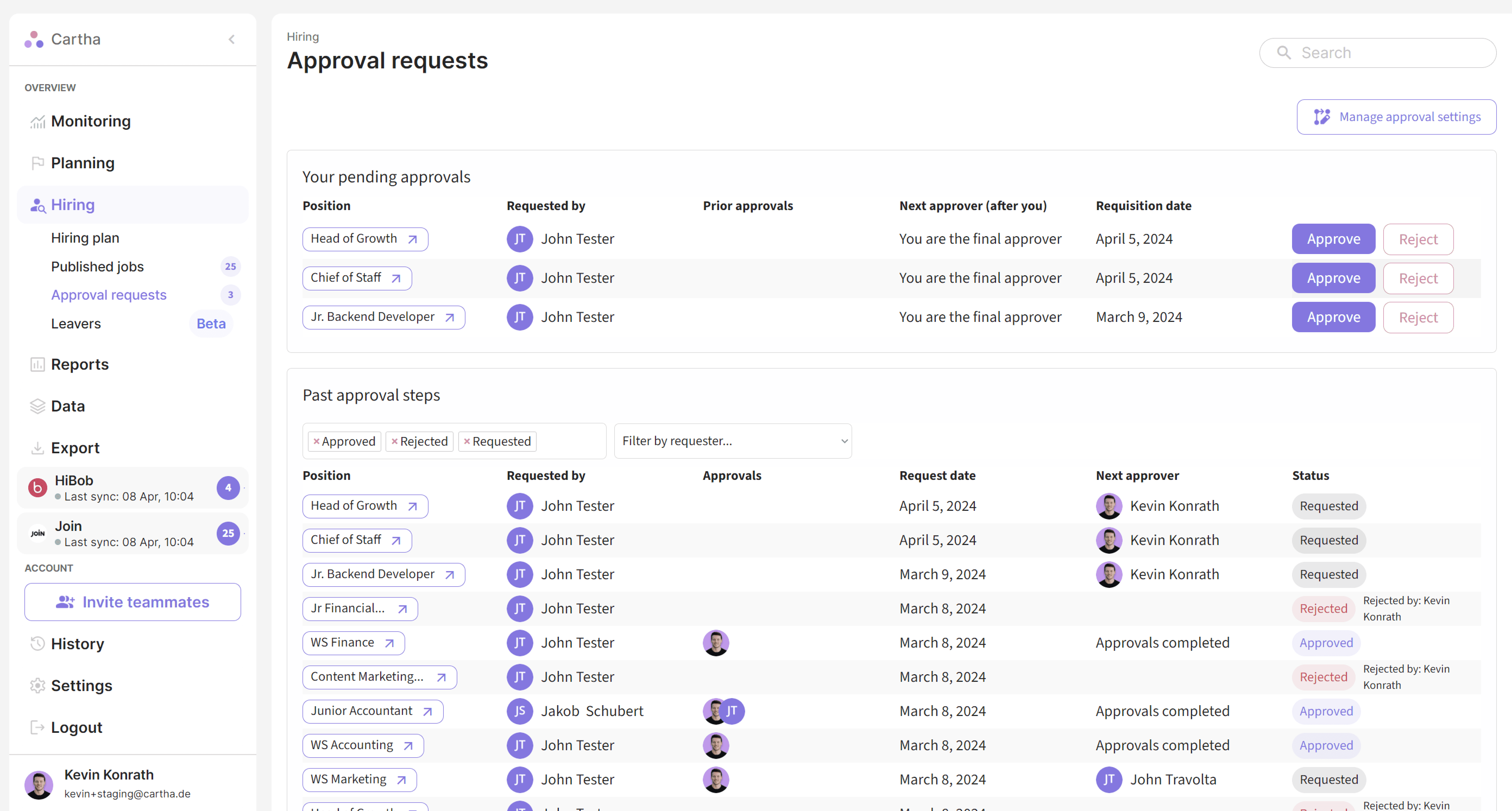
Mar 22, 2024 |
Headcount planning is a vital part of organizational growth, ensuring that every new hire not only fits the company’s current needs but also its future direction. It’s more than just adding numbers; it’s about making strategic decisions that align with the company’s goals, budget, and operational requirements.
At the core of this process is the approval mechanism — a critical checkpoint that evaluates each request for a new position. This process — sometimes managed more implicitly, sometimes carefully designed — assesses the necessity, impact, and timing of each potential hire, ensuring they are a right fit and can contribute positively to the organization’s objectives.

Setting up approval states properly is an important cornerstone when bringing structure into approvals. It’s tempting to dive into automating this workflow, seduced by the gains of efficiency and speed. However, embracing the KISS (Keep It Simple, Stupid) principle in the early stages prioritizes data correctness and simplicity over complex automation in first steps. Only when the volume of requests justifies the investment should organizations move towards more sophisticated tools and processes for managing and automating approvals.
Key Takeaways
Approval states: Understand the four main approval states and their implications.
Separation of concerns: Keep approval states distinct from planning states to maintain clarity.
Automation timing: Automate the approval process only when the volume of requests makes it necessary, not before.
Tool support: Utilize headcount planning tools like Cartha for managing approval states and automating the approval process when appropriate.
The Four States of Approval
Generally speaking, we can define four distinct states of approvals — Requested, Approved, On hold, and Cancelled. Each state represents a critical checkpoint that determines the trajectory of a headcount request.
Requested: This initial stage signifies that a request for a new position has been made but not yet reviewed. This state is usually skipped when a new position is directly added by the CFO or CEO.
Approved: The green light. An approved state means the request has passed through the necessary evaluations and is deemed essential and viable within the company’s current strategy and budget. Only planned positions in this state will be considered in the latest forecast. Hence, it is critical to pay more attention to planning assumptions such as expected start dates or compensation.
On Hold: A pause, not a stop. Requests in this state are temporarily frozen, often due to shifting priorities or pending further information. The state helps to keep track of positions that are pending approval before being considered in the financial forecast.
Cancelled: The end of the line for a request. A cancelled state indicates that, upon review, the position is no longer needed or feasible, marking a request’s withdrawal from the planning process. Keeping track of cancelled positions can help draw conclusions about reasoning in prior planning phases.
Separation from Planning States
Distinguishing approval states from planning states — i.e. planned, active, onboarding, leave, and inactive — is crucial for clarity and effectiveness in headcount management. This separation ensures that the approval process, which focuses on the decision-making regarding new hires, remains distinct from the operational aspects of managing existing workforce statuses.
Planned: Positions that are budgeted for but not yet filled. A strategic anticipation of future needs.
Active: Employees currently working and contributing to the company’s objectives.
Onboarding: The process of integrating a new hire into the organization, but has not started working yet.
Leave: Employees temporarily away from work for various reasons, including maternity, paternity, sick leave, or sabbatical.
Inactive: Former active positions that have terminated the contract, e.g. due to resignation or layoff.
Maintaining a clear distinction between these categories enables a more structured approach to workforce planning, enhancing both strategic alignment and operational efficiency.
Approaching Automation Wisely
The temptation to automate the approval process early on can lead to premature complexity. Adhering to the KISS principle (Keep it simple, stupid)in the initial phases is vital, focusing on ensuring data accuracy and simplicity. Automation should only come into play when the volume of requests and the organizational structure demand it, facilitating a seamless transition to a more efficient and effective process.
Before automation, prioritize:
Data correctness: Ensuring that all information is accurate and up-to-date to make informed decisions.
Simplicity: Keeping the process straightforward to avoid unnecessary complications and bottlenecks.
When moving to automation, consider:
Predefined approval managers: Assigning specific individuals the responsibility to approve requests streamlines the process.
Automatic notifications: Informing managers of pending approvals through automated systems ensures no request goes unnoticed.
Tailored interfaces: Developing user-friendly platforms that treat approvals as tasks can significantly enhance efficiency and response times.
This approach not only preserves resources but also prepares the organization for a smoother transition to automated processes, aligning with the evolving needs of the business.
Leveraging Headcount Planning Tools
Headcount planning tools like Cartha play a pivotal role in supporting both states of the approval process — manual and automated. These platforms offer a dual advantage:
First, by clearly defining and managing the approval states of each headcount request, organizations can maintain a tight grip on their workforce expansion, ensuring each step is justified and aligned with overarching goals. Cartha also ensures data quality by preventing illogical state combinations (e.g. active and cancelled or requested and active).
Second, as the organization grows and the volume of requests justifies the need for automation, these tools seamlessly transition into systems that facilitate efficient approval workflows. Features such as predefined approval managers, automatic notifications, and task-oriented interfaces can transform the approval process from a bottleneck into a streamlined operation.

Choosing the right tool is not just about the features it offers but also about its ability to grow and adapt with the organization. As companies navigate the complexities of headcount planning, the right support system can make all the difference, turning strategic vision into operational reality.
Conclusion
The approval process in headcount planning is a nuanced journey, from the initial request to the final decision. It serves as a critical checkpoint, ensuring that every addition to the team is not only necessary but also a strategic fit within the broader organizational context. Navigating this process with a blend of strategic foresight and operational efficiency is key to maintaining balance and fostering growth.
By understanding the distinct approval states, maintaining a clear separation from planning states, approaching automation with caution, and leveraging the right tools, organizations can ensure their headcount planning process is both effective and aligned with their strategic objectives. As we look towards the future of work, mastering these elements of headcount planning will be esstentail in building agile and resilient organizations.
FAQs
What is the importance of separating approval states from planning states?
Separating approval from planning states ensures clarity and efficiency in workforce management. It allows organizations to distinctly manage decision-making processes regarding new hires separately from the operational status of current employees, enhancing strategic alignment and operational execution.
When should a company consider automating its approval process?
A company should consider automating its approval process when the volume of headcount requests and the complexity of managing these requests manually justify the investment in automation. This typically occurs at a scale where manual processes become inefficient or prone to errors.
How can tools like Cartha support the headcount planning process?
Tools like Cartha can support the headcount planning process by providing platforms for managing approval states and automating the approval process. They offer features such as predefined approval workflows, automatic notifications, and user-friendly interfaces that streamline the process, making it more efficient and aligned with organizational needs.







